Can cats also get diabetes? Diabetes in cats is diagnosed and treated! Diabetes in cats is a nutritional metabolic syndrome caused by defective insulin secretion, impaired biological action, or both. The clinical symptoms of the disease are three more, one low and one high, namely polydipsia, polyphagia, polyuria, weight loss and elevated blood sugar. Clinically, the incidence of felines is not high, but with the increase in the number of pet cats in recent years, coupled with the increase in species of pet treats, the number of obese cats has increased. The incidence of diabetes has also increased. This article will share with you the diagnosis and treatment of feline diabetes.
I. Incidence
Brown pear (details) Cat, 10 years old, female cat, weighing 9kg. The pet owner found that the cat has lost appetite and lack of energy in recent days. Recently, the cat's appetite has increased, the amount of urine has increased, the urine has a smell of rotten apples, and the weight has decreased significantly. , currently only 5 kilograms, was brought to this hospital for treatment. General clinical examination revealed that the cat was lethargic, lethargic, emaciated, and mildly dehydrated. The abdominal circumference was significantly increased, the abdomen was fluctuated when palpated, the abdominal wall was tense, and the patient cried continuously during palpation.
2. Laboratory tests
1. Routine blood tests
The results of blood routine examination are as follows:
It can be seen from the table that all values are high to the normal value.
2. Serum biochemical test
The results of blood biochemical test are as follows:
The results in the table are as follows: Glucose, triglyceride Esters, total cholesterol, and globulin were all elevated compared with the normal reference value; albumin was lower than the normal value, and A/G was decreased.
3. Urine examination
Urine analysis was performed with Mindray urine analyzer. The analysis results are as follows: Urine specific gravity is lower than 1.00, urine pH is 6.1, grape is lower than 1300 U/L, urine ketone body is lower than 85 mg/dL, urine occult blood and leukocytes are positive. , 2 consecutive urinalysis tests in morning urine obtained stable results, and both urine glucose and urine ketones were positive.
4. Imaging examination
Using X-ray machine to conduct abdominal lateral examination, the examination results are: abdominal uterine horns are enlarged, and the gray shadow is filled with fluid.
5. B-ultrasound image examination
Abdominal examination was carried out with B-ultrasound machine, and the examination results were: abdominal uterine horn swelling, uterine wall thickening, and liquid black shadow.
Clinical diagnosis
The cat had been in an obese body before the onset of the disease, and often ate fatty meat and Fish, according to the general clinical symptoms and general clinical physical examination, the disease can be initially diagnosed as diabetes complicated with pyometra. Combined with the results of urinalysis and serum biochemical tests, the cat was diagnosed with diabetes. Serum globulin and albumin are lower than normal, and the possibility of other diseases can be considered. The number of white blood cells, red blood cells and neutrophils in routine blood examination were higher than normal values. Combined with the results of X-ray imaging examination and B-ultrasound examination, the disease was diagnosed as diabetes complicated with pyometra.
Four. Treatment
According to the cat's examination, the treatment plan is to use insulin to lower blood sugar, use lipid-lowering drugs to lower blood lipids, and infusion to correct water Electrolyte and acid-base balance disorders, combined with symptomatic therapy and diet therapy. After physical recovery, hysterectomy and oophorectomy are performed under the conditions permitted by the examination results.
1. Insulin combined with hypoglycemic drug therapy
Synthetic long-acting insulin was used for subcutaneous injection of 8U half an hour before feeding in the morning and evening, and 1.6 mg of hypoglycemic was taken orally after meals, once a day ; Lipingzhi, orally 2 times a day. Adjust the morning and evening insulin dosage according to the basal blood sugar and postprandial blood sugar levels. Regularly measure blood sugar levels, and adjust the ratio of morning and evening doses according to the relative level of blood sugar levels after breakfast and dinner, until blood sugar fluctuations are controlled within the normal range.
2. Daily feeding and management
Daily regular and quantitative feeding of Royal diabetes Prescribe cat food, control the total water intake, and take a small amount of drinking water frequently. Until the blood sugar returns to the normal range, adjust the daily eating habits.
3. Symptomatic therapy and control of secondary infection
Intravenous infusion of lactated Ringer's solution and normal saline. Since polyuria and ketoacidosis are easy to be associated with hypokalemia, an appropriate amount of potassium chloride solution should be supplemented during intravenous infusion, and antibiotics such as ceftriaxone sodium should be given to control infection according to the results of urine output and ketone body examination in animals.
4. Hysterectomy and Ovariectomy
After a period of treatment, the cat's physical condition gradually After recovery, hysterectomy and oophorectomy were basically performed under surgical conditions. Under general anesthesia with a breathing anesthesia machine, the abdominal cavity was routinely opened, the uterus was found, the mesentery was ligated, the broad ligament of the uterus was separated, the uterus was ligated and excised, and the abdominal wall incision was routinely closed. Systemic antibiotics were given for 7 days after the operation, analgesics were given, and a collar was put on.
V. Discussion and Summary
1. Obesity is the cause of diabetes, and the increase in blood glucose concentration caused by diabetes stimulates the hypothalamus feeding center to increase appetite , which also increases plasma osmotic pressure and vascular permeability, resulting in a positive clinical urine glucose test; at the same time, due to the decreased ability to decompose glucose, the body cannot use enough glucose as an energy source, resulting in an increase in relative energy consumption, and glucose is excreted and taken away in urine The amount of water also increases, which eventually leads to an increase in the body’s appetite, weight loss and weight loss, and a decrease in immunity, abnormal secretion of endometrial hormones, which acts on the uterine wall mucosal damage, secondary bacterial infection, and causes uterine serous exudative inflammation. With more and more effusion, feline diabetes complicated with pyometra appeared.
2. When treating diabetes in cats, we must pay attention to the dosage of insulin. If the dosage is too much, it will cause iatrogenic hypoglycemia. The dosage of insulin should be injected according to the daily measured blood sugar results, and the injection time should be fixed at about half an hour before feeding. The toxins in the uterus of cats complicated with pyometra were absorbed into the body, resulting in death from sepsis. Therefore, in the treatment of diabetes at the same time to control the pyometrial lesions, systemic antibiotics to control the secondary infection.
3. The treatment of diabetes should attach great importance to the treatment of complications, and once symptoms similar to diabetes are found, they should be treated as soon as possible to avoid delaying the best time for treatment.
![[Dog Training 5] The training method of pet dog dining etiquette](/static/img/12192/12192_1.jpg)



